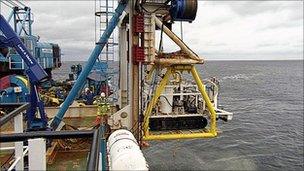Caithness seabed fragment among most radioactive found
- Published

The fragment was recovered using a remotely operated vehicle
A particle linked to the Dounreay nuclear power plant and found on the seabed nearby is one of the most highly radioactive to be recovered so far.
It contained 100 million becquerels (Bq) of radiation.
The Dounreay Particles Advisory Group (DPAG) consider radioactivity greater than a million Bq of Caesium 137 as a health risk.
The find was made by a team using a remotely operated vehicle to clean up the seabed off the Caithness site.
The particles of Caesium 137 are filings from nuclear fuel rods reprocessed at Dounreay during the 1960s and 1970s.
Flushed into the sea through the plant's liquid discharge pipe, they have been turning up on local beaches for nearly three decades.
Since August, when the latest phase of the seabed clean up started, 429 fragments have been recovered from the seabed.
Dounreay Site Restoration Limited (DSRL) said 81 were above the threshold for being classed as "significant".
If left on skin, a particle of above a million Bq could cause serious ulceration after one to two weeks, according to DPAG.
The other 348 were categorised as "relevant" and "minor".
In total, 1,533 fragments have been recovered from the seabed.
- Published1 October 2010
- Published30 September 2010